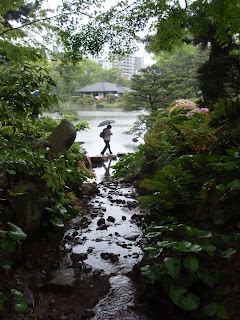About four kilometers north of Hiroshima sits a heritage site over 400 years old.
Right next to Fudoinmae Station, up a short path, nestled in between some much-more modern buildings, sits Fudo-in.You first approach the Roumon gate, built in 1594.
The wood used in the construction of the gate was apparently brought back from Korea after the 1592 invasion.
The gate has two protectors...
They look quite old, and scary.
I wonder when this gate was last closed. Even if it was, you could just walk around it now.
Beyond it lies the Kondo (main hall), built in 1540. It wasn't open when I arrived. It was still raining up here when I arrived.
Another view of the Kondo.
A shrine off to the side.
And more.
There was one building open on the grounds.
I believe this is the treasure hall. Someone more familiar with Buddhist temples could chime in and correct me if I'm wrong.
There are a good number of treasures to be found inside.
More stuff.
There is also a bell tower which I somehow missed, which was also built in the 16th century.
The roofs of the buildings were damaged by the atomic bomb in 1945, but the structures remained intact and are the only real historic buildings that remain in Hiroshima.
As mentioned above, Fudo-in is easily reached by train to the Fudoinmae Station. The temple is on the east side, just down the stairs. Head towards the left away from the tracks. You can see a map here.




























































